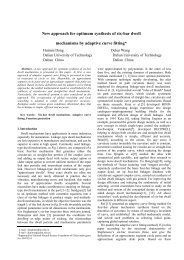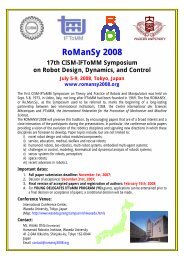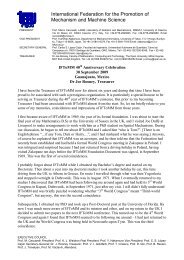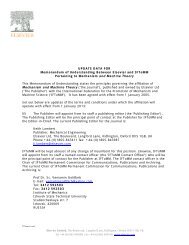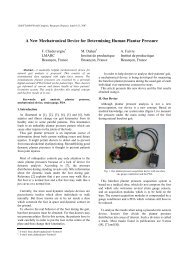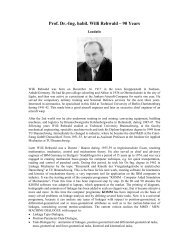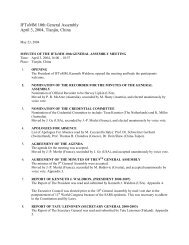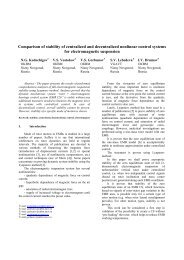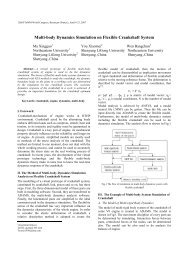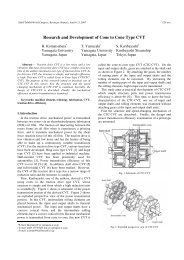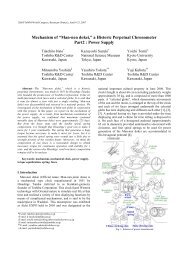A simple technique for measuring the base helix angle of ... - IFToMM
A simple technique for measuring the base helix angle of ... - IFToMM
A simple technique for measuring the base helix angle of ... - IFToMM
Create successful ePaper yourself
Turn your PDF publications into a flip-book with our unique Google optimized e-Paper software.
12th <strong>IFToMM</strong> World Congress, Besançon, June 18-21, 2007 406<br />
p = W − W<br />
(10)<br />
bn k + 1 k<br />
( 1) 1<br />
sbn k W k W<br />
k k +<br />
= − − (11)<br />
Quantity s bn is one <strong>of</strong> <strong>the</strong> four elemental parameters <strong>of</strong><br />
<strong>the</strong> gear. As <strong>for</strong> p bn , its known value is instrumental in<br />
laying down an equation in <strong>the</strong> remaining unknown<br />
parameters, i.e., ρ and β b . By merging Eqs. (2) and (3), <strong>the</strong><br />
ensuing condition is obtained<br />
z pbn<br />
ρ cos βb<br />
= (12)<br />
2 π<br />
whose right-hand side has to be considered as known (Eq.<br />
(10)).<br />
The last <strong>of</strong> <strong>the</strong> required measurements is <strong>the</strong> overpin<br />
measurement F a , taken with pins <strong>of</strong> known diameter a.<br />
This measurement results in a value <strong>for</strong> parameter e (see<br />
Eq. (6)). An equation set composed <strong>of</strong> Eqs. (7), (8), and<br />
(12) can now be considered that has ρ, β b , and ϑ as<br />
unknowns. Insertion <strong>of</strong> expression (12) <strong>for</strong> ρ cosβ b into<br />
Eq. (8) leads to<br />
π ⎛ sbn<br />
+ a ⎞<br />
invϑ<br />
= ⎜ − 1⎟<br />
z ⎝ pbn<br />
⎠<br />
(13)<br />
All quantities on <strong>the</strong> right-hand side <strong>of</strong> Eq. (13) are known<br />
a priori (pin or ball diameter a), or have already been<br />
determined (z, s bn , and p bn ). There<strong>for</strong>e Eq. (13) – which<br />
has a classical <strong>for</strong>m in involutometry – can be solved <strong>for</strong><br />
unknown ϑ by a numeric iterative algorithm (bisection,<br />
Newton-Raphson, etc.).<br />
Once <strong>the</strong> value <strong>of</strong> ϑ has been determined, Eq. (7)<br />
linearly yields <strong>the</strong> value <strong>of</strong> ρ<br />
ρ = ecosϑ<br />
(14)<br />
Finally <strong>the</strong> <strong>base</strong> <strong>helix</strong> <strong>angle</strong> β b can be found via Eq. (12)<br />
−1<br />
⎛ z pbn<br />
⎞<br />
βb<br />
= cos ⎜ ⎟<br />
⎝ 2 π ρ ⎠<br />
(15)<br />
This concludes determination <strong>of</strong> <strong>the</strong> four basic<br />
parameters <strong>of</strong> <strong>the</strong> inspected gear, i.e., z, ρ, β b , and s bn . If s b<br />
is <strong>of</strong> interest instead <strong>of</strong> s bn , <strong>the</strong>n Eq. (4) simply allows<br />
such a replacement.<br />
B. One span measurement and two overpin measurements<br />
The first <strong>of</strong> <strong>the</strong> proposed new <strong>technique</strong>s is presented<br />
hereafter.<br />
As soon as <strong>the</strong> outcome <strong>of</strong> one span measurements W k<br />
and two overpin measurements F a1 and F a2 are available,<br />
it is possible to lay down <strong>the</strong> following set <strong>of</strong> six<br />
equations (see Eqs. (1), (12), (13), and (7))<br />
( 1)<br />
⎧Wk = k − pbn + sbn<br />
⎪<br />
⎪<br />
z pbn<br />
ρ cos βb<br />
=<br />
⎪ 2 π<br />
⎪<br />
⎪ π ⎛ sbn<br />
+ a ⎞<br />
1<br />
invϑ1<br />
= − 1<br />
⎪ ⎜ ⎟<br />
z ⎝ pbn<br />
⎠<br />
⎪<br />
⎨ π ⎛ sbn<br />
+ a ⎞<br />
2<br />
⎪invϑ2<br />
= ⎜ − 1⎟<br />
⎪ z ⎝ pbn<br />
⎠<br />
⎪ ρ<br />
⎪cosϑ1<br />
=<br />
⎪ e1<br />
⎪ ρ<br />
⎪cosϑ2<br />
=<br />
⎪⎩ e2<br />
where quantities e i (i=1,2) are given by (see Eq. (6))<br />
Fai<br />
− ai<br />
ei<br />
= =<br />
⎡π<br />
⎛ z ⎞⎤<br />
2sin ⎢ int ⎜ ⎟<br />
z 2 ⎥<br />
⎣ ⎝ ⎠⎦<br />
( i 1,2 )<br />
(16)<br />
(17)<br />
In Eq. (17), a 1 and a 2 are <strong>the</strong> known diameters <strong>of</strong> <strong>the</strong> first<br />
and second pairs <strong>of</strong> identical pins (or balls). Equation set<br />
(16) has six unknowns, namely, p bn , s bn , ρ, β b , ϑ 1 , and ϑ 2 ,<br />
which can be determined as shown hereafter.<br />
The expression <strong>of</strong> s bn obtainable from <strong>the</strong> first <strong>of</strong> Eqs.<br />
(16) is first inserted into <strong>the</strong> third and fourth <strong>of</strong> Eqs. (16)<br />
z<br />
invϑi<br />
+ k<br />
π<br />
1<br />
= =<br />
W + a p<br />
k i bn<br />
( i 1,2 )<br />
(18)<br />
By equating <strong>the</strong> left-hand sides <strong>of</strong> Eqs. (18) <strong>for</strong> i=1 and<br />
i =2, <strong>the</strong> ensuing condition can be derived<br />
π k<br />
+<br />
2<br />
inv<br />
1<br />
−<br />
k<br />
+<br />
1<br />
inv<br />
2<br />
+<br />
2<br />
−<br />
1<br />
= 0 (19)<br />
z<br />
( W a ) ϑ ( W a ) ϑ ( a a )<br />
k<br />
Now <strong>the</strong> last two <strong>of</strong> Eqs. (16) are solved <strong>for</strong> ϑ 1 and ϑ 2<br />
ϑ<br />
ρ<br />
( i )<br />
−1<br />
i<br />
= cos = 1,2 (20)<br />
ei<br />
These expressions <strong>for</strong> ϑ 1 and ϑ 2 are inserted into Eq. (19)<br />
⎛<br />
Wk<br />
+ a e − ρ − ρ cos<br />
⎝<br />
( )<br />
ρ ⎞<br />
⎟<br />
⎠<br />
2 2 −1<br />
2 ⎜ 1<br />
e1<br />
⎛<br />
− ( Wk<br />
+ a ) ⎜ e − ρ − ρ cos<br />
⎝<br />
π kρ<br />
+ ( a2 − a1<br />
) = 0<br />
z<br />
2 2 −1<br />
1 2<br />
ρ ⎞<br />
⎟<br />
e2<br />
⎠<br />
(21)<br />
Equation (21) contains <strong>the</strong> radius <strong>of</strong> <strong>the</strong> <strong>base</strong> cylinder, ρ,<br />
as only unknown, which can <strong>the</strong>re<strong>for</strong>e be determined by<br />
resorting to a numeric algorithm <strong>for</strong> solving univariate<br />
transcendental equations. Subsequently, once ϑ 1 has been<br />
computed by <strong>the</strong> first <strong>of</strong> Eqs. (20), <strong>the</strong> first <strong>of</strong> Eqs. (18)<br />
3



